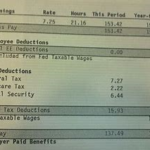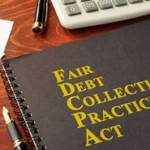 I had the amazing privilege to attend the Consumer Assembly last week in Washington DC, and there was a panel discussion on credit scoring. The panel was actually a discussion on a group of American consumers that are dubbed by the industry the, “Credit Invisibles.” These are people who cannot get a “good” credit score in the typical way, by having open lines of credit that are at least six months old. The industry that scores credit, including the Fair Isaac Corporation (FICO), the developers of the FICO credit scoring models, and Vantage Score Solutions, LLC, the developers of the Vantage credit scoring models, feel that “credit invisibles” are disadvantaged in receiving access to credit products. And they are, but this new model by FICO to address the credit invisibles and those with marginal credit is not good for consumers.
I had the amazing privilege to attend the Consumer Assembly last week in Washington DC, and there was a panel discussion on credit scoring. The panel was actually a discussion on a group of American consumers that are dubbed by the industry the, “Credit Invisibles.” These are people who cannot get a “good” credit score in the typical way, by having open lines of credit that are at least six months old. The industry that scores credit, including the Fair Isaac Corporation (FICO), the developers of the FICO credit scoring models, and Vantage Score Solutions, LLC, the developers of the Vantage credit scoring models, feel that “credit invisibles” are disadvantaged in receiving access to credit products. And they are, but this new model by FICO to address the credit invisibles and those with marginal credit is not good for consumers.
I first blogged on the new “UltraFICO” score back in October in a two-part article series. The first was an introduction to the scoring model and the second was on some unspoken dangers related to judgments and bank account attachment when the credit reporting agencies have you bank account information, which you must consent to disclose under this model.
During last week’s panel discussion I learned more about the purpose of the model, and some facts that have me re-thinking my original posts about how this score may be “OK” for a mortgage product. And I was wrong in my previous posts. The model is not “OK” for any credit. None.
Before I move on to the specifics, I have to take a moment and point out that the panelists, including the VP from FICO from whom I received the information directly, entered into the lion’s den of an audience of consumer advocates, and spoke openly and answered questions about their products. That was a very nice thing to do, and I am appreciative of their honesty. I also know that in their “heart of hearts” they believe that they are helping consumers. It is at that point, I cannot disagree more. Remember, the credit scoring businesses are in the business to help people get and stay in debt. Any model that they can create to help consumers access credit is good for them, not necessarily for you. They sell these models. You are denied under one, they offer a second. Here are five “Fun Facts” about the UltraFICO:
1. The “UltraFICO” will be marketed, and is intended, for all types of credit not just secured, collateralized mortgages. In my original post, I speculated that the releasing of banking information to show the history of cash transactions might be “ok” or even great for mortgage lending, the only good use I could envision for this model. Well, when you apply for a mortgage, the banks take your last months of bank statements anyway. So, for that credit product, this appears to be moot. The UltraFICO will be available to all creditors who wish to purchase it.
2. The UltraFICO is intended to be a “second chance” credit scoring model. This little piece of information was new to me, and this is the first indication that it is not good for consumers. I originally believed that borrowers could just “opt-in” to this model by consenting to include their banking info. Actually, this is intended to be an option for people who would be denied credit in the original model. The credit denial becomes a “maybe” and the borrower has the option to “consent” to include their banking info in the hopes that their credit score will go up and they can be approved.
3. The Premise of the UltraFICO by Fair Isaac is faulty. One telling thing about this model is the statement by the panelist that the checking account information would be reliable because, “Consumer’s are in control of those accounts.” I disagree. I had a debit card number stolen and used in a fish market in Mexico. Filed the report, got the money back, but in this day and age of data breaches, I would never make the statement that consumers are always in control. FICO assured us that their model would be able to determine these little situations and not count them, but the scoring models are not transparent. All types of situations can arise where a consumer, for a period of time, may not be in complete control of every transaction in their account.
4. The UltraFICO model needs two to three years of banking information. Ah, another tidbit of info I was previously lacking. To use this model, consumers must 1. not have bounced a check in the last twelve months 2. Have at least two to three years of checking account information available for the model and 3. Have an average balance of $400.00. Good to know. 78% of consumers live paycheck to paycheck. There are many consumers that cannot maintain an average $400.00 balance after bills are paid and groceries are purchased. The VP assured us that in the beta-testing, using Experian as the Credit Reporting Agency (CRA), most consumers had their score increase under this model. But this now provides the information that a consumer may know they do not have, and “opt-out” of the model, rather than be denied AND have a score decrease.
5. Your banking info will be out there to the CRA, including “new” Finicity, who will become a CRA to comply with the Fair Credit Reporting Act. A fourth CRA will enter into the picture, Finicity who will be the CRA for these UltraFICO banking information providers to FICO for scoring. Because FICO never sees anything but the “raw data” they have zero, none, no liability for what happens to your info. Under this model, FICO assures us that it will be a “single use” calculation of the borrowers banking info. Okay, what happens then? The CRA and the creditors are responsible for protecting the data and are subject to the FCRA, so, it’s good. Or is it?
Data breaches have recently revealed sensitive info that an identity thief can use to create an account, such as social security number and date of birth. But now, a breach can put your banking info at risk, no need to create a fake account when they can raid yours, or use the UltraFICO themselves. How many additional hours will consumers add to the identity theft cleanup mess when the bank must investigate everything, and to close that account could subject the consumer to bounced checks and whatever else. But, you can file a dispute with the Credit Reporting Agency online. Eyeroll.
If you are purchasing a house, find a bank who will perform manual underwriting, and do not use the UltraFICO to provide your banking account information. Please. Your info will be out on the internet for who knows how long. Even if the CRAs pinky swear to delete it. For other types of credit, if you are going to be denied without this info- you are going to be denied. The interest rate is likely higher than you would expect anyway once the UltraFICO model is used. And for the car dealers and others who will “deny” people initially to access their banking information for approval, we know, we know. If you give a mouse a cookie, he will want a glass of milk. Protect your banking from the UltraFICO.



 Lots of news floating around about how a new legislative proposal where the federal government would take
Lots of news floating around about how a new legislative proposal where the federal government would take  The National Consumer Law Center (NCLC) recently published a
The National Consumer Law Center (NCLC) recently published a  flickr.com
flickr.com
 Credit: nlipw.com
Credit: nlipw.com photo:credit.org
photo:credit.org